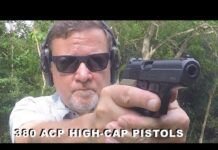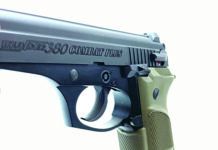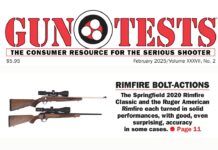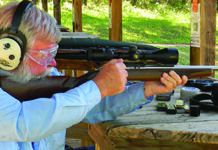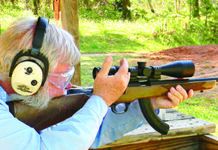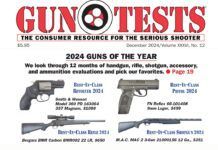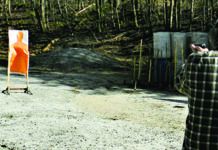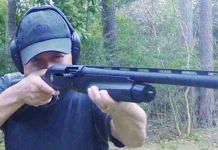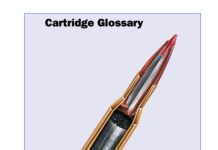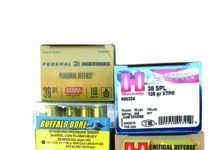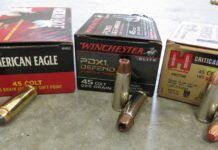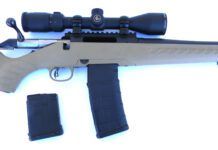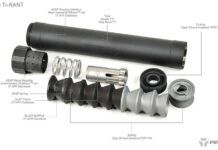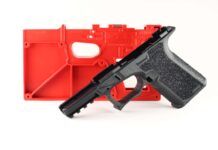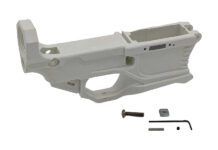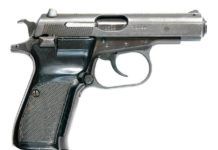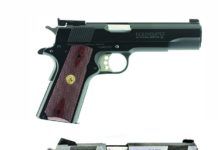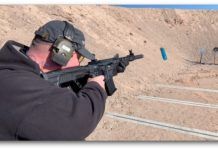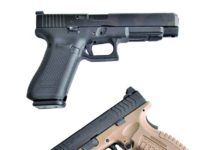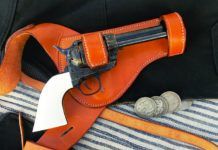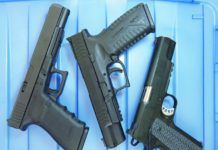Speedloader Enthusiasm
Readers have had a lot of challenges finding good wheelgun reloading devices. We were happy to help. Also, Reader Gail wonders about the 6.5 PRC, but not so much that a change is in the cards.
VALUE GUIDE: 1911 Pistol Ratings
Log on toGun-Tests.comto read complete reviews of these products in the designated months.Highly-ranked products from older reviews are often available used at substantial discounts.
Compact 1911s: Two Pretty Good 45 ACPs for the Money
There should be a saying: Once you shoot a 1911, you won't go back. That's how some of our testers feel about the 1911 platform, which in a properly executed handgun will have a nice trigger, comfortable grip angle, good sights, and plenty of power in 45 ACP. And 1911s that you might carry don't have to have a big footprint, so with that in mind, we looked at a Commander and two Officer-size 1911 pistols with a street cost of about $450. Inexpensive doesn't necessarily equate to value in a 1911, but with the two Officer models, one each from Taurus and Taylor's, and a Commander from American Tactical, Inc. (ATI), we found some value-packed compact 1911s. Not perfect by any means, but good performance for the cost. Of course there are compromises, but that is to be expected in a 1911 that costs about $450. In fact, if we could disassemble and reassemble these compact 1911s into one optimal compact 1911, we would take the trigger from the ATI, the sights from the Taylor's, and the receiver from the Taurus.
The 5 Best 380 ACP Pistols
What many concealed carry consumers do is use Gun Tests grades and write-ups to identify problems and things to look for when purchasing a firearm. But the final decision has to be made by the buyer, because a gun should fit the shooter like a pair of well-worn shoes. That requires very personal decision-making for the CCW licensee. With that said, here are five handguns I believe stand out above the others if you're looking for a handgun with modest recoil.
Revolver Speedloaders: Proven Designs and New Innovations
During the past year, revolvers have gotten a lot of attention. The introduction of the Taurus AirLite six-shot revolver, basically a six-shot J frame, was interesting. Ruger introduced a seven-shot 357 Magnum version of the GP100. The revolver, it seems, continues to interest the self-defense shooter who wants his or her carry handgun to agree with the Keep It Simple Stupid (KISS) maxim. We have done reports on revolvers and on self-loading pistol magazines, but we've never tested revolver speedloaders. It seemed long overdue. We got together a team of revolver shooters, collected a number of revolvers, and ordered a range of revolver speedloaders. While the basic design of all speedloaders is similar, we discovered that there are important differences in the speedloaders that will be important to the user. Whether the speedloader is used for competition or defense, we think the reader who carries a revolver would be well advised to carry a speedloader, master the technique to deploy it, and choose the device well.
45 ACP 1911s: We Test Five From Les Baer, SIG Sauer, Colt
The 1911 is a legendary handgun, and it has been offered in many variations since its introduction 108 years ago. During the time after World War I, there were attempts to make the 1911 into a more accurate handgun, primarily for use at Camp Perry. The first National Match handguns were modified by Army gunsmiths for the task. Colt made the pistol commercially available as the National Match during the 1930s. The first guns featured high-profile fixed sights and were considerably tightened over the fit of the Government Model. Colt offered the Gold Cup pistol as a target pistol set up for light loads. Today, we like to have a 1911 with a lighter trigger action than the GI gun and with superior sights, but do we really need an expensive handgun or a target gun for overall utility? For personal defense and most forms of competition, the handguns reviewed will do a good job. They are useful for personal defense, some forms of competition, and for hunting varmints, and even medium-size game, at moderate range. The trick is, how much do you have to pay for this performance?
New Springfield 380s and 9mm Pistols
Springfield Armory is so excited to have two new models that we introduced here for SHOT Show. The first one being the 9 millimeter version of the 380 that we introduced last year.
So that one I can show you here. Very similar to the one that comes in 380. It has G10 grips, G10 trigger, AmeriGlo's Pro Glo tritium front sight, so it really picks up quickly in just about any sort of light condition. Really quick sight picture acquisition there. Let's see what else. We have ambidextrous safety, we have this golf ball texturing - what we call Octo-Grip texturing on the front and the back straps so it really gives you a comfortable grip without tearing up your clothing if you're going to carry it concealed.
SHOT Show 2019: Shotguns, Ammo, Compact Pistols, and Aftermarket AR Trigger
At SHOT 2019, Gun Tests Editor Todd Woodard rustled up some interesting products that are beginning to appear this spring. Here's a quick look at new self-defense ammo from Browning and Winchester, a new shotgun from Armscor, new compact pistols in 9mm and 380 ACP from Springfield Armory, and a new drop-in trigger for your favorite AR-15 from American Tactical.
Big 9mm Shootout: Glock, CZ, FN, and Springfield Compete
Handguns are designed to give the user a certain amount of useful power in a portable configuration. For home defense, the limits on "portable" are less restrictive than those for concealed carry under covering garments. Weight is a big issue for carry, but length competes with mass as the dimension that causes the biggest pain in the back. But for performance, length is helpful when it allows for a longer barrel that will make for greater velocity and energy, and up top, a longer slight radius on the slide generally improves accuracy. Also, a longer front end tends to dampen sight movement during recoil, important when chambering a more powerful cartridge such as the 357 SIG. As such, a certain class of handguns — long barrel/long slide models — answer a lot of needs for home-defense shooters, and for the right people, could even be carried. In this report, we looked hard at four 9mm Luger pistols that are among the longest offerings in their respective stables, they were:
- the CZ-USA CZ P0-9 91620 at 8.1 inches in overall length;
- the FNH FNS-9L Longslide 66725 at 8.25 inches OAL;
- the Glock G34 Gen5 MOS PA3430103MOS at 8.74 inches OAL;
- and the Springfield XD(M) 4.5 XD(M)T9459FDEHCE Threaded Barrel, whose 5.3-inch-long barrel contributes to its 8.3-inch OAL.
The CZ P0-9 is a longer version of the CZ P0-7, yet in this group, the barrel is the shortest of the test at 4.54 inches, or 0.79 inch longer than the CZ P0-7's. This pistol also features an elongated grip that holds 19 rounds in the magazine versus 15 for the P0-7. An important difference between this pistol and the smaller P0-7 is that the P0-9 is supplied with interchangeable backstraps. To put it in scale, the well-known CZ 75 B is also 8.1 inches long, but the 75 B is 0.4 inches shorter than the P0-9 and holds three fewer rounds in its magazines. Interestingly, the pistol retails for an average $100 less than the smaller P0-7. This product from Cesk zbrojovka Uhersk Brod is a polymer-framed pistol, but unlike the others tested, the P0-9 is hammer fired. We expected the CZ pistol to handle differently from the striker-fired guns, and it did.
FN America pitches the FNS-9 Longslide as a competition gun (as does Glock for its G34), saying the Longslide has been "tested in every type of major shooting event, from high-speed IPSC/USPSA and grueling 3-gun matches to precision bull's-eye and actions events like the NRA Bianchi Cup." Okay, none of that scares us if we're looking for a dependable, easy-to-shoot self-defense handgun.
The Glock G34 Gen5 is likewise designated as a competition pistol, but it's not Glock's largest 9mm by quite a bit. The G17L Long Slide gets that honor with a 6.02-inch-long barrel and an OAL of 9.53 inches.
Oddly, Springfield's XD(M) 4.5 TB (now discontinued in the two-tone color scheme) is longer than what the company designates as a competition handgun, the 5.25-inch-barrel XD(M)95259BHCE Competition Series 9mm. Despite its nomenclature, the threaded-barrel XD(M) version we test here has a 5.3-inch-long barrel to accommodate the threads and is 0.05 inch longer overall than the 5.25 Model, according to company specs.
Here's what we found out about these longer-than-average handguns.
Which Cowboy Revolver? We Test Three 357 Magnum Guns
We recently tested three single-action traditional-style revolvers in the popular 38 Special/357 Magnum chambering to find which revolver would be best for Cowboy Action Shooting. We also considered the merits of each as a trail gun. While some may scoff, there are many single-action revolvers in use for home protection, including protecting the homestead against predators, so we had to consider this role as well. The three revolvers were from Traditions Performance Firearms: the Sheriff's Model, the Liberty Model, and the Frontier Model. The qualifying difference between the three revolvers are their barrel lengths, though in this test, they are vastly different overall. The longer the barrel, the greater the weight of the revolver as well. The barrels were 3.5, 4.75, and 5.5 inches long. While we liked the 5.5-inch barrel the best based on balance, point, and fast-paced accuracy, the gun itself was the roughest revolver tested as far as the trigger action went and the only one that gave trouble. It wasn't difficult to get it up and running, but this just isn't welcome in a new revolver. On the other hand, the Sheriff's Model was a fun gun to shoot, but not the most practical. We cannot recommend it for CAS competition, but it makes a good recreational handgun and perhaps even a personal-defense revolver for those skilled with the single action. The 4.75-inch-barrel Liberty revolver was the most accurate revolver and was well finished with beautiful laser engraving. It was more accurate than the longer-barrel revolver from the benchrest but not as easy to get a fast hit with on the action course.
When you choose a single-action revolver for Cowboy Action Shooting, a sense of style and history are important. Reliability and good value are also important. When considering the single-action revolver, the 7.5-inch barrel length is regarded as too large and heavy by most shooters. A shorter-statured shooter may find the muzzle in his boot tops in a conventional holster. The fit, finish, and barrel length and balance, then, are important. For recreational use, one may be as good as the other. The greatest accuracy, velocity and handling advantages are more important in a handgun to be used in CAS competition. Considerations other than accuracy, such as heft and fast handling, are important. The speed of the draw is important. The so-called Tall Draw with a long-barrel revolver isn't as fast as with the shorter handguns. This fact gave birth to the original SAA that came to be known as the Gunfighter's barrel length. The barrel was cut right to the ejector rod, and this resulted in a 4.75-inch-barrel revolver. The compromise 5.5-inch barrel length was often called the Artillery revolver and issued to cannoneers. The short 3-inch-barrel revolver was called the shopkeep's or, more popularly, the Sheriff's Model. We tested all three to determine which has an advantage.
The caliber wasn't difficult to choose. While the 45 Colt, 44-40 and 38-40 may be more authentic to the time period, the 38 Special is the superior cartridge for competition today, we believe. The larger calibers are sometimes smoky when downloaded. The 38 Special responds well with Cowboy Action loads. If you desire, the 357 Magnum cartridge may be loaded for use as a trail gun or as a defensive handgun. Anyone who uses the SAA revolver well in CAS competition would be a formidable opponent in a home-defense situation.
For ammunition, we chose three loads, one in 38 Special and two in 357 Magnum. We used a handload consisting of the Magnus cast bullets 200-grain RNL ($49.10 for 500 bullets from MagnusBullets.com) and enough Titegroup powder for 720 fps. This is an outstanding load with plenty of bearing surface for accuracy. It hits the steel plates hard. Next, we used the Black Hills Ammunition 357 Magnum 158-grain cowboy load ($30.30/50 rounds from AmmunitionToGo.com). Loaded to 805 fps on average, this load offers the ease of loading of the full-length Magnum case but is loaded to 38 Special velocity. Finally, we used the Federal 125-grain JHP as a general-purpose 357 Magnum load to determine how the pistols perform with Magnum loads. It costs $21.30/20 rounds. While Cowboy Action guns are seldom fired with full-power ammunition, for Gun Tests, Magnum loads were an important part of the evaluation equation.
Perfect 10s? We Test a Trio Of Big-Bore Semi-Automatics
In the past few years there has been a renewed interest in the 10mm Auto. That is odd because the birth of the 40 S&W Auto cartridge nearly suffocated the 10mm Auto out of existence. Not only are there more pistols chambered in 10mm, there is ammo loaded to velocities the 10mm Auto was designed for. Ammunition manufacturers like SIG and others provide these big-bore semi-autos with cartridges that live up to the 10mm's reputation.
Two 10mm Autos introduced in 2018 are from Springfield Armory (SA). SA chambered both the XDM and 1911 platforms in the round and, back in 2015, Glock got the hint from handgun hunters that we wanted a full-fledged 10mm for hunting, and the company obliged with the G40 Gen4 with MOS (Modular Optic System). We liked all three of these pistols because they all offered good accuracy, excellent to good triggers, and they were easy to shoot well. But we preferred one over the others.
How We Tested
No jams. No failures. All pistols ran well and met our expectations of Springfield and Glock pistols. We averaged 2-inch five-shot groups at 25 yards using open sights across all three pistols. When we attached a red dot (actually a green dot), we found that the Glock pulled ahead of the group in ease of shooting. We like the G40 for its ability to mount an optic. And if you are paying attention, you may have guessed the RO Elite Operator offered the best accuracy with open sights. There is something to be said about the 1911 platform's single-action trigger. SA tuned this trigger nicely. Some of us were shooting cloverleaf patterns with holes overlapping each other using a rest with the Range Officer Elite Operator.
Ammo used during testing consisted of SIG Sauer V-Crown and FMJ cartridges loaded with a 180-grain JHP and FMJ bullets, respectively. We also had on hand some old Hornady Critical Defense 165-grain FTX ammo. All of these loads cranked out the muzzle doing a respectable 1200 fps on average.
For fast, unsupported shooting, we found these pistols do serve up recoil, but the pistols allowed us to manage it. Could we shoot these 10mms as fast as a 9mm or 45 ACP? Sure we could, but our accuracy decreased.
As a hunting round, the 10mm Auto can be effective on boar and deer if you know your limitations and those of the round. Maximum range with this round is 50 yards. With a muzzle energy of 550 to 600 foot-pounds with our test ammo, you could use these pistols as you would a 357 Magnum revolver. There are boutique ammunition manufacturers, such as Buffalo Bore, Grizzly, and Underwood, that we have experience with and have fired their hotter loads designed for penetration and expansion. Some of the larger ammo makers like Hornady and Federal also make rounds suitable for hunting medium-size game.
Are these three pistols perfect 10s? In our opinion they are close, but one may be more suited to your shooting style. The devil is in the details, and we had a devil of a time wringing out these 10mms.


